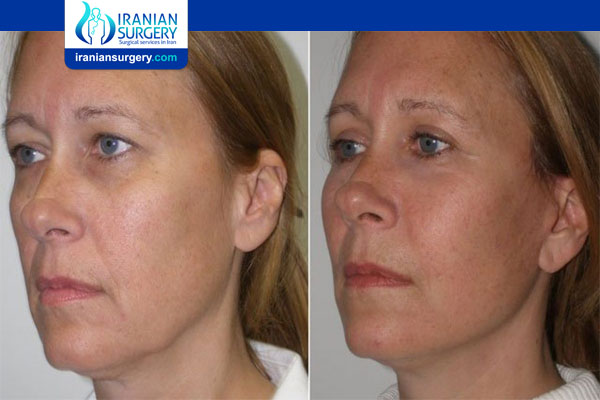Cheek Implant Revision
Cheek Implant Revision
Many patients seek a change to the shape or volume of their upper cheek area (“cheekbone”, also known as the zygoma or malar eminence), alone or in combination with other aesthetic enhancements such as blepharoplasty (eyelid lift) or rhytidectomy (facelift or neck lift). In most cases, the desired procedure is cheek augmentation (enlargement). Revision cheek implant surgery (removal or replacement) is the procedure to correct or change the results of a prior cheek implant surgery. When cheek implant placement is unsatisfactory, the problem can be fixed.
The most common reason that patients seek secondary cheek implant surgery is improper position or placement of the implant or migration of the implant after surgery. Cheek implants may be placed via an incision inside the mouth, between the gums and the upper lip and cheek, or via a lower eyelid incision.
This choice is made based on the size of the implant and whether other surgical procedures are being performed concurrently. The trans-oral approach (incision in the mouth) sometimes results in placement of the implant too low in the cheek. This can give the patient an unnatural fullness next to the nose and upper lip, which is particularly obvious when speaking or making facial expressions.
The trans-blepharoplasty approach (incision in the lower eyelid) can result in implant placement too high in the cheek. This makes the lower eyelid appear full and may change the apparent shape of the eye, particularly when smiling. In addition, scar formation around an implant placed through this approach can tether the lower eyelid to the cheekbone, causing difficulty with closure of the eye (lagophthalmos or ectropion) or an increase in the amount of the white of the eye (sclera) which is visible (scleral show).
The second most common reason patients decide to revise a cheek implant is that they do not like the size or shape of the implant selected by another surgeon. Modern cheek implants come in many sizes and shapes and can vary in design to include only the upper cheek (malar region) or the upper and middle cheek (malar and submalar regions).
Another variety of implant sits directly on the orbital rim (eye socket), and provides volume enhancement in the region of the lower eyelid. Indications for implant placement in this area are rare. Selection of the proper type and size of cheek implant requires a detailed conversation with the surgeon, including analysis of patient photographs or computer-enhanced imaging. We always dedicate a significant amount of time to this pre-operative discussion, as he believes it is crucial to a successful aesthetic outcome.
Finally, there are rare cases where the primary cheek implant has become infected and must be removed. An acute infection should be dealt with by the surgeon who placed the implant; however, in some patients, infection manifests as a latent or indolent phenomenon and may be related to the presence of a biofilm. Biofilms are bacterial infections that form on mucosal surfaces or foreign bodies, and have been described in all types of cosmetic implant surgery and even with soft tissue fillers. It is often necessary to remove the implant when a biofilm is suspected. The patient must then allow the area to “cool off” with antibiotics for a few weeks before considering revision implant surgery (replacement).
Sometimes patients decide that they do not want cheek augmentation at all. In these cases, the cheek implant is removed via the same incision as it was placed, and the incision for access is then meticulously closed or revised as needed. With the implant removed, the patient’s face generally returns to its pre-operative appearance. If the implant that was removed was very large, it is possible that the underlying maxilla (upper jaw bone) will be remodeled (flattened or thinned) or the overlying skin stretched and loose. In these cases, we offer the patient autologous fat grafting to fill in the facial volume deficiencies and scar revision to remove excess skin whenever possible.
These procedures are typically undertaken after adequate healing from the implant removal has occurred, to better assess the contour abnormalities and to allow the wound to contract.
Revision cheek implant surgery can be performed under light sedation and may accompany other cosmetic or reconstructive procedures. Cheek implants can be an excellent complement to blepharoplasty (eyelid lift) or face and neck lift surgery. With subtle increases in the projection of the malar region or changes in the shape and contour of the cheeks, significant improvements in the harmony between facial areas can be achieved.
Who is a Candidate?
Anyone who has had cheek implants placed but is unsatisfied with the result or has had complications may be a candidate for cheek implant removal or revision. Cheek implant removal or revision may be a stand-alone procedure or can be combined with other aesthetic or reconstructive surgeries.
The key to any facial implant surgery is identifying the most appropriate size and shape of the implant – to achieve the greatest aesthetic enhancement, while still looking natural.
Please note that all patients are different and individual healing times and results may vary. The statements regarding procedures and recovery made here are general rules.
About Iranian Surgery
Iranian surgery is an online medical tourism platform where you can find the best cosmetic surgeons in Iran. All surgeons working with Iranian Surgery specialize in plastic surgery and perform cheek implant Revision surgery in well-equipped hospitals, so after cheek implants in Iran you will face the least possible complications.
For more information about the cost of cheek implant Revision in Iran and to schedule an appointment in advance, you can contact Iranian Surgery consultants via WhatsApp number +98 901 929 0946. This service is completely free.
Source:
. https://www.sanfranciscofacialplasticsurgery.com/cosmetic-surgery/revision/cheek-implant-revision


